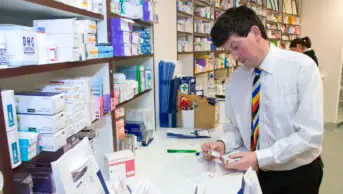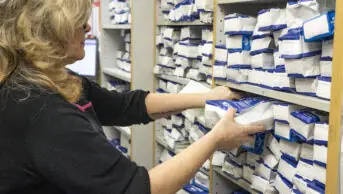
Callie Jones
The evolution of pharmacy practice in recent decades has been a global phenomenon, with the most striking changes occurring in the developed world[1]
. In several countries, the emergence of expanded scopes of practice and new professional services models has proceeded rapidly, especially in the past decade, with minimum progress towards practice change observed in other countries[2]
. Even within countries, expansion of scopes of practice has varied between regions. For example, in the UK, pharmacists have the opportunity to become independent prescribers within their scope of practice while, in Canada, only a few provinces have introduced independent prescribing[3],[4]
. In the United States, many but not all states allow for pharmacist participation in the prescribing process under the auspices of collaborative practice, whereby agreements or protocols are established between physicians and pharmacists depending on state regulations or laws, with limited examples of independent prescribing[5]
.
This raises questions about the reasons for these differential rates of development. Are there barriers to sharing information about best practice internationally? Why have we not been able to translate best practice models shown to be effective in one setting to another or one country to another?
Barriers to sharing best practice
At an international level, information sharing and evidence of successful best practice models in pharmacy is facilitated through peer reviewed and grey literature, and international pharmacy conferences. There is now a wealth of literature describing the development, implementation and evaluation of a wide variety of pharmacist-delivered cognitive services (i.e. those unrelated to the supply of medicines). Examples of these services and programmes include medicines management[6]
, such as medication reviews in hospitals and medicines use reviews in the community[7],[8]
, and adherence support services. Pharmacists in the UK, United States and Canada are currently involved in public health activities, such as screening for diabetes and cardiovascular risk, weight management, smoking cessation and other lifestyle modification programmes[9]
. The UK, Canada, United States, New Zealand and some European governments have also integrated pharmacists into primary care[10],[11]
.
Factors which impact on pharmacy’s capacity to translate knowledge of evidence-based practice from one setting to another include: the wealth of information available; wide differences in healthcare systems; government legislation on ownership of community pharmacy and control of medicines; the structure of the pharmacy sector; the power and influence of the medical profession; the availability of GPs; the education of pharmacists; and systems of pharmacist reimbursement.
Consider the UK, where the government exercises full control of national health policy and the allocation of health resources. In this context, sectional interests of individual healthcare professionals have little influence on policy direction[12]
. Taking into account shortages of GPs and the need to contain drug costs and reduce the burden of medicines-related harm, it has adopted policies that have facilitated role expansion for pharmacists. Changes to the NHS pharmacy contractual framework specify and reimburse pharmacists for services at three levels: essential services, advanced services, and enhanced and locally commissioned services[13]
.
In contrast, in Canada, there is a national health insurance model whereby providers are private but are paid by the government from a national pool of funds generated from payments by the public. In this setting, the government still wields a great deal of control over resource allocation and is not subject to undue influence from sectional interests. The drug budgets, however, are made up of block payments managed at the provincial level and all negotiations for expanded scopes of practice and their reimbursement have taken place at the provincial level, thus explaining the differences observed between provinces[14]
. Shortages of family physicians have also influenced the introduction of pharmacist prescribing authority in some provinces.
In Australia, there is a mixed private-public system where the government funds basic payments to primary care practitioners through a national insurance scheme, Medicare, and provides access to subsidised medicines though a national formulary known as the Pharmaceutical Benefits Scheme[15]
. Pharmacists are reimbursed under a contract known as the community pharmacy agreements (CPAs). Over successive CPAs, payments to pharmacists for medicines management and other cognitive services have been gradually introduced and have thereby driven some shifts in pharmacy practice towards provision of cognitive services[16]
. Notably, however, Australian pharmacists are not yet permitted to prescribe. Any move in this direction has been fiercely resisted by the medical profession, a strong lobby group in Australia[17]
.
The other extreme can be seen in the United States where there is a market-based health insurance system with many health insurance models covering reimbursement to pharmacists. This has contributed to wide disparities in the implementation of medication therapy management and other pharmacist cognitive services[18]
.
In much of the developing world, the user-pays system for healthcare is still the norm. In the absence of policy direction and government support or reimbursement for role expansion, community pharmacy still operates predominantly within the medicines supply model, with some nascent development of public health services in smoking cessation, weight management and screening for undiagnosed disease[19]
.
Differences in pharmacy curricula and programmes across the globe also contribute to the different pace of implementation of best practice models. Wide variation in the length and scope of experiential placements in pharmacy degree programmes result in differences in levels of clinical skills of graduates in different countries[20]
. To embrace expanded scopes of practice, advanced practitioner role models are needed to educate and mentor entry level pharmacists.
Even in countries where best practice models have been successfully implemented by “early adopters”, many practitioners have been reluctant to follow suit. It has been suggested that pharmacists often lack confidence, fear new roles, are stuck when faced with ambiguity, always need approval and are risk averse. A cross-sectional survey of Canadian pharmacists identified that more than half (57%) of respondents viewed themselves as “dispensers of medication” and not as patient-centred practitioners[21]
.
How to increase sharing
Globally, policymakers are increasingly recognising the need to realise the full potential of pharmacists in healthcare. However, governments in many countries are still grappling with questions around which specific health services should be provided by pharmacists and if and how they should be funded. An initiative that would support greater sharing of successful pharmacy models would be the establishment of a repository of such models with detailed implementation guidelines, tools to guide service implementation, training, and documentation systems hosted by a global organisation such as the International Pharmaceutical Federation (FIP). In the sphere of pharmacy education, the academic section of FIP has already been proactive in developing reports over recent years to disseminate information on best educational practice from the undergraduate level to continuing professional development and advanced practice[22]
. In the UK, the Royal Pharmaceutical Society runs the Map of Evidence database, which collates existing evidence and ongoing initiatives that can inform policy and practice, the sharing of good pharmacy practice and innovation, and knowledge exchange and learning in pharmacy and pharmaceutical sciences.
Global sharing of evidence-based pharmacy practice models is certainly an important component that is needed to advance pharmacy practice, as is appropriate education and practice support to help practitioners transition to effective implementation. But, importantly, what we also need are health policy reforms that will better integrate pharmacists into the healthcare system and fair systems of reimbursement to drive practice change.
Ines Krass is professor of pharmacy practice at the University of Sydney, Australia.
References
[1] Mossialos E, Naci H & Courtin E. Expanding the role of community pharmacists: policymaking in the absence of policy-relevant evidence? Health Policy 2013;111:135–148. doi: 10.1016/j.healthpol.2013.04.003
[2] Hughes CM, Hawwa AF, Scullin C et al. Provision of pharmaceutical care by community pharmacists: a comparison across Europe. Pharmacy World & Science 2010;32:472–478. doi: 10.1007/s11096-010-9393-x
[3] Law MR, Ma T, Fisher J et al. Independent pharmacist prescribing in Canada. Canadian Pharmacists Journal 2012;145:17–23. PMCID: PMC3567533
[4] American Pharmacists Association. A tale of two countries: The path to pharmacist prescribing in the United Kingdom and Canada. 2014. Available at: http://www.pharmacist.com/tale-two-countries-path-pharmacist-prescribing-united-kingdom-and-canada (accessed June 2016)
[5] American Pharmacists Association. States give pharmacists more prescriptive authority. 2015 Available at: https://www.pharmacist.com/states-give-pharmacists-more-prescriptive-authority (accessed June 2016)
[6] American Pharmacists Association. Medication Therapy Management. 2014. Available at: http://www.pharmacist.com/mtm (accessed June 2016)
[7] Pharmacy Guild of Australia. Home Medicines Review (HMR). 2012. Available at: http://www.guild.org.au/NSW_Branch/professional-services/guild-clinical—hmr-qum (accessed June 2016)
[8] Blenkinsopp A, Bond C & Raynor DK. Medication reviews. Br J Clin Pharmacol 2012;74:573–580. doi: 10.1111/j.1365-2125.2012.04331.x
[9] Eades CE, Ferguson JS & O’Carroll RE. Public health in community pharmacy: a systematic review of pharmacist and consumer views. BMC Public Health 2011;11:582. doi: 10.1186/1471-2458-11-582
[10] Tan EC, Stewart K, Elliott RA et al. Pharmacist services provided in general practice clinics: a systematic review and meta-analysis. Res Social Adm Pharm 2014;10:608–622. doi: 10.1016/j.sapharm.2013.08.006
[11] NHS England. More than 400 pharmacists to be recruited to GP surgeries by next year. 2015. Available at: https://www.england.nhs.uk/2015/11/pharmacists-recruited/ (accessed June 2016)
[12] NHS England Choices. The NHS in England. 2015. Available at: http://www.nhs.uk/NHSEngland/thenhs/about/Pages/overview.aspx (accessed June 2016)
[13] NHS Employers. Community Pharmacy Contractual Changes. 2015. Available at: http://www.nhsemployers.org/your-workforce/primary-care-contacts/community-pharmacy/community-pharmacy-contractual-framework-changes/cpcf-changes-2015-16 (accessed June 2016)
[14] Marchildon GP. Canada Health system review. Health Systems in Transition 2013;15:1–179. Available at: http://www.euro.who.int/__data/assets/pdf_file/0011/181955/e96759.pdf (accessed June 2016)
[15] Australian Government DoHS. The Pharmaceutical Benefits Scheme. 2015. Available at: http://www.humanservices.gov.au/customer/services/medicare/pharmaceutical-benefits-scheme (accessed June 2016)
[16] The Pharmacy Guild of Australia. Community Pharmacy Agreement. 2015. Available at: https://www.guild.org.au/the-guild/community-pharmacy-agreement (accessed June 2016)
[17] Australian Medical Association. AMA takes strong stance on non-medical prescribing. 2012. Available at: https://ama.com.au/media/ama-takes-strong-stance-non-medical-prescribing (accessed June 2016)
[18] Department for Professional Employees. The US health care system: an international perspective. 2014. Available at: http://dpeaflcio.org/programs-publications/issue-fact-sheets/the-u-s-health-care-system-an-international-perspective/ (accessed June 2016)
[19] Hermansyah A, Sainsbury E & Krass I. Community pharmacy and emerging public health initiatives in developing Southeast Asian countries: a systematic review. Health Soc Care Community 2015. doi: 10.1111/hsc.12289
[20] International Pharmaceutical Federation (FIP). Quality assurance of pharmacy. Education: the FIP Global Framework. 2014. Available at: http://www.fip.org/files/fip/PharmacyEducation/Quality_Assurance/QA_Framework_2nd_Edition_online_version.pdf (accessed June 2016)
[21] Rosenthal MM, Breault RR, Austin Z et al. Pharmacists’ self-perception of their professional role: insights into community pharmacy culture. Journal of the American Pharmacists Association 2011;51:363–367. doi: 10.1331/JAPhA.2011.10034
[22] International Pharmaceutical Federation (FIP). FIP education and workforce publications. 2015. Available at: http://www.fip.org/educationreports (accessed June 2016)


